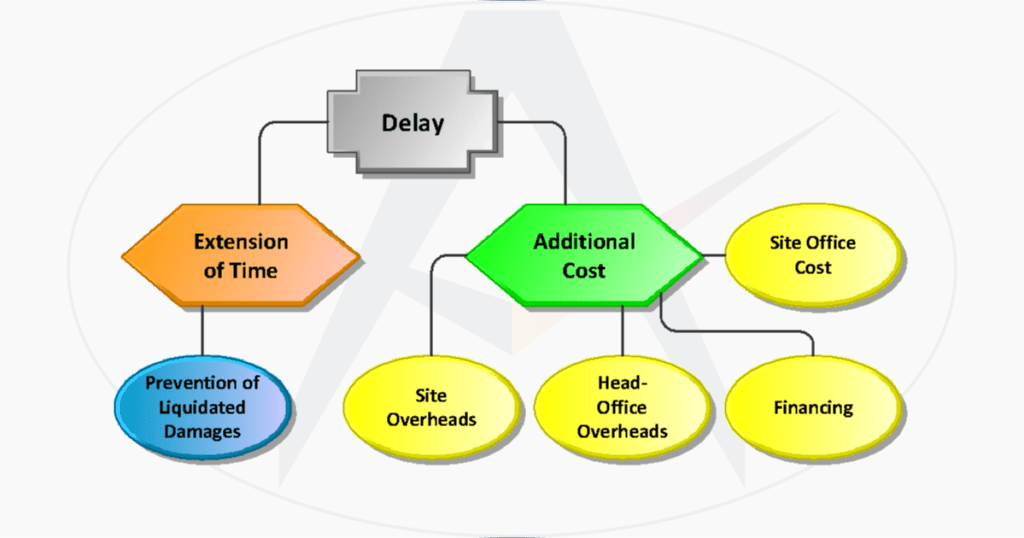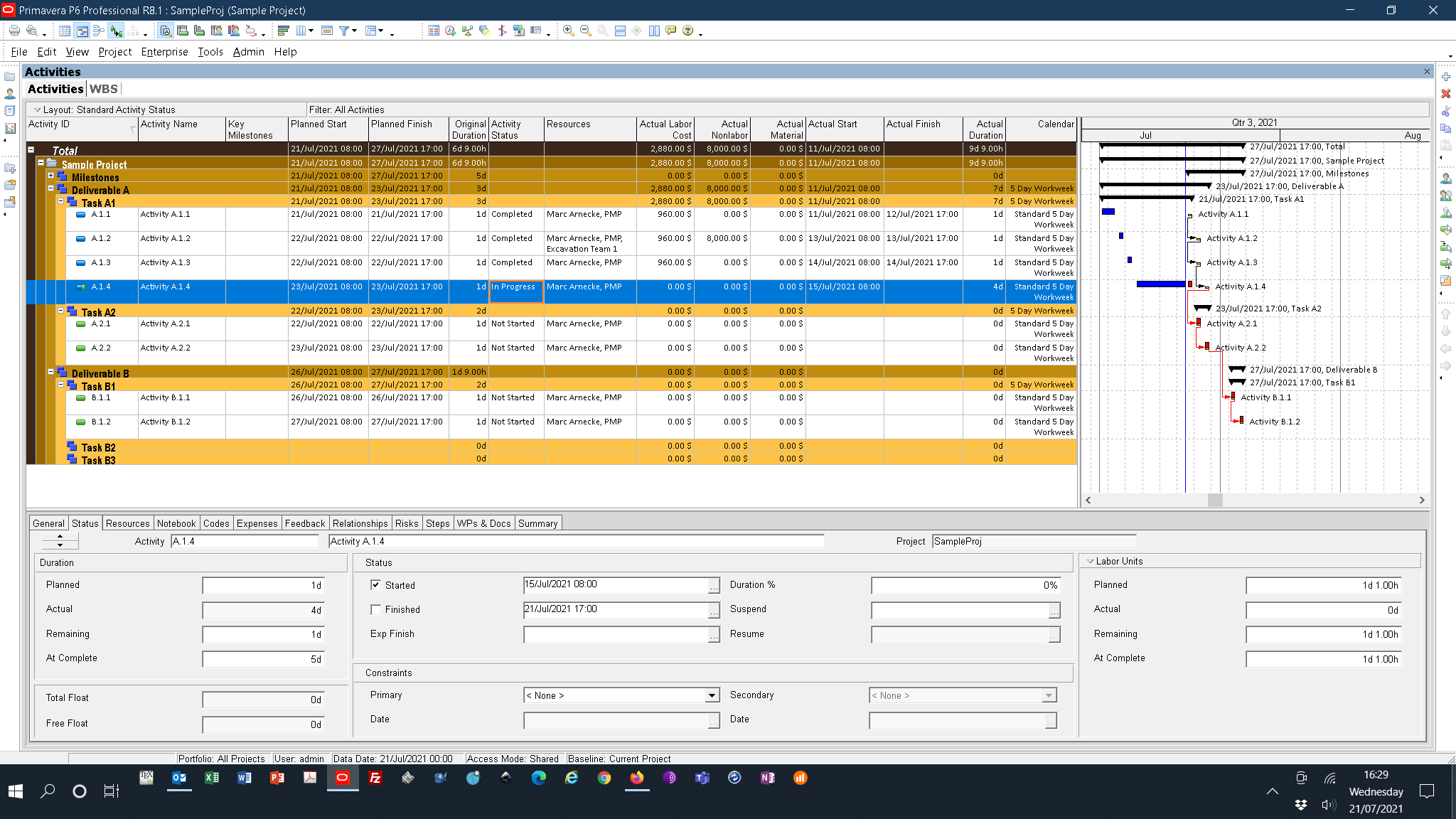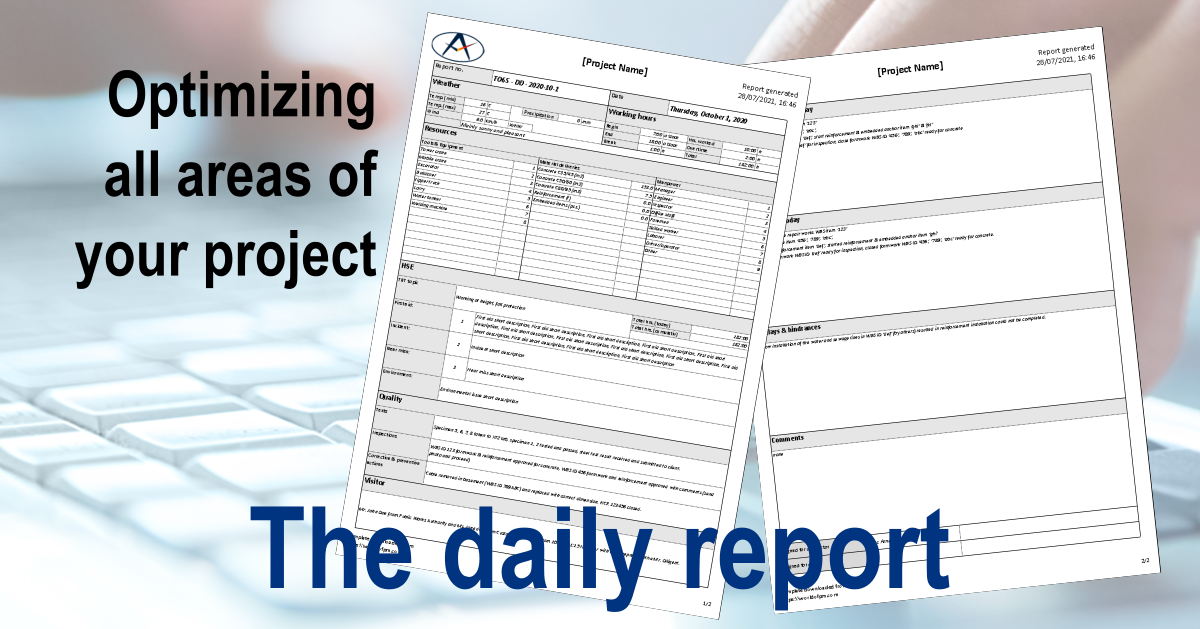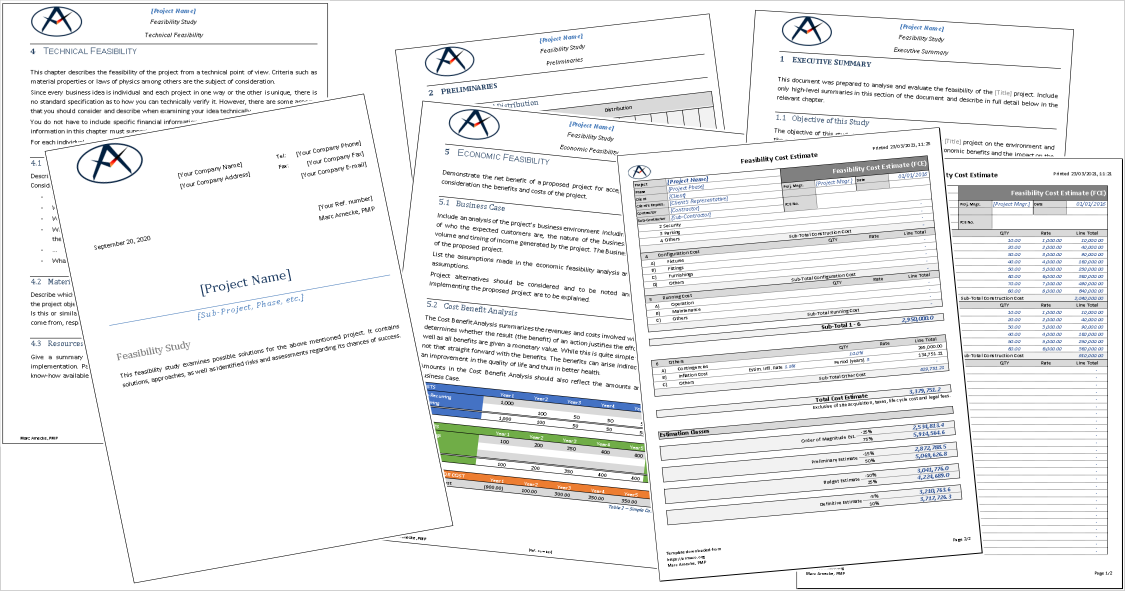Claim for Extension of Time (EoT) and associated costs are very common for many construction projects. They come about because of delays. If these delays are beyond the control and responsibility of the contractor, he can apply for an extension of the contract duration and claim the additional costs incurred. Such a claim is referred to as an Extension of Time and Associated Costs.
In the following, I will go into more detail on when this can usually apply and what needs to be considered.
The earlier in your project life cycle you deal with the topic, the lower the risk that there will be disagreements and losses at the end.
Would you like some FREE sample templates?
Tell me where to send them...
Your email address will not be passed on to third parties. It will only be used to send you a few samples today and in the next few days.
In this Article about Claim for Extension of Time (EoT) you will find the following information
- Introduction
- Common claim variants
- Reasons that can lead to EoT claims
- What is a claim for extension of time?
- Schedule updates
- Identification
- Reporting
- What are the entitlements?
- How to prepare the claim for extension of time (EoT)?
- What are common mistakes?
- Template Reviews
- Templates download
- Conclusion
There is one thing I have to point out to you. I am not a legal advisor for the preparation of EoT or any other claims!!! Following my advice about a claim for extension of time and using my templates should help you, but in no way equates to legal advice. It is up to you to study your contract carefully and follow it correctly, as well as any legal, municipal or other regulations. It may well be that there are fundamental differences.
Introduction to the Claim for Extension of Time
Claims are very widespread in the construction industry and very often lead to frustration on the part of the contractor as well as the client
If you have to prepare a claim, you have a lot of work to do and can expect a lot of frustration and unfortunately silly answers. In this short article I want to show you quickly and without wasting too much of your precious time how to prepare a claim for Extension of Time (EoT) and Associated Cost and how to avoid frustration.
There are different types of claims, which are briefly mentioned below for the sake of completeness. However, here I am concerned with the Extension of Time Claim (EoT). EoT claims are based on time delays. Below I go into examples of such time delays. In principle, these are delays for which the contractor is neither responsible nor has control over them.
It is important to follow the rules to increase the chances of success. In principle, there is still a claim, even if some rules were not strictly followed. However, following the rules increases the chances of success, simplifies the claim considerably, and reduces frustration. I'll tell you below what you should do.
To increase your chances of success with your Claim for Extension of Time and to simplify your work download some helpful EoT templates.
What are Common Claim Variants?
As already mentioned, the focus of this article is the Claim for Extension of Time and Associated Cost. But I don't want to go unmentioned that there are also other claim variants.
Common Claim Types:
- Prolongation claims,
- Acceleration claims,
- Disruption claims,
- Damage claims (usually raised by clients & other parties),
- Extension of time claims,
- Variations claims,
Reasons that can lead to Extension of Time Claims
In principle, the delays that can lead to an EoT claim are delays that the contractor cannot control or be responsible for. The following list contains examples of such EoT claims.
- Delay in handing over the job site,
- Use or occupation by the employer of any part of the permanent works, except as may be specified in the Contract,
- Different physical conditions from those provided during the tender stage,
- Changes to the original contract scope,
- Late engineering deliverable,
- Late procurement deliverables,
- Frequent revisions for engineering deliverable,
- Delay in approval above the contractual allowance
- Delay in payment,
- Out of sequence for engineering and procurement deliverables,
- Suspension of the work,
- Adverse weather conditions,
- Changes to project specifications,
- Force Majeure (War, hostilities, invasion, act of foreign enemies’ revolution, terrorism, sabotage by persons other than the contractor’s personnel, or civil war within the country, etc.),
- Existing underground utilities which are not shown in the as-built drawing received by the contractor during the tender stage.
Who prepares the Claim for extension of time (EoT)?
The project manager, who usually involves the quantity surveyor and planning engineer, is responsible for preparing the claim. The preparation of claims is very time-consuming and involves a lot of admin work. Surprisingly, contractors often try to avoid even minor costs for a little bit of advice, research, or a few templates, even though the claim is often about many thousands of Euros.

What is a Claim for Extension of Time?
An Extension of Time Claim (EOT) is a request to change the scheduled completion date due to a delay beyond the contractor's control. The delay may be caused by natural events, owner delays or other unexpected events as highlighted above.
The process for filing an EOT claim is usually specified in the contract between the client and the contractor. Most often, these conditions require a written notice of delay and an official claim with backup documentation. If the extension is approved, a change order will be issued.
The contractor must notify the client in writing if a delay becomes apparent or has even occurred that could justify or necessitate an adjustment to the schedule baseline. The underlying delay event or the circumstance that may cause a delay must be described including the cause, the liability, and the impact and the extension must be requested. The request should be referenced to the corresponding contractual clause(s).
The request letter is evaluated by the client and leads to a written rejection or a change order. A template for such a notification (also referred to as a Change Request) is included in my EoT template set.
Usually contracts require notifications to be submitted within a certain time, otherwise, they may be denied. Adhering to such deadlines increases the chances of success considerably. Disregard and late filing usually result in lengthy disputes, often involving legal departments.
Detecting delays or disruptions can be a complicated and time-consuming process that needs to be done with great accuracy. The quality of the information provided and the records available are usually the keys to successful claims. The records must be conclusive, logically structured, and presented understandably. The claim must include the cause and the liability, as well as the impact of the delay suffered by the contractor as a result of the delay.
Proving delays in complex projects with schedules containing thousands of activities with many interfaces and many causes of delays and disruptions is a complicated process and involves many details.
Regular Schedule Updates help Identify Delays
In basically all projects, everything revolves around detailed and accurate planning. Beside the project management plan and all the subsidiary plans, project managers and their teams particularly rely on three baselines.
Common Baselines are:
- The scope baseline,
- The cost baseline (budget), and
- The schedule baseline.
All three baselines can be the subject to adjustments. However, the EoT claim deals with the schedule baseline.
The schedule baseline is often created as part of the bidding documents and becomes a part of the contract. Meeting these milestones is essentially what it is all about. The reality unfortunately is that the schedule baseline at this point is often prepared rather superficially based on assumptions. It is only converted into a more detailed plan in retrospect.
To secure a contract, unrealistic promises are occasionally made on the part of the contractor and contractors hope to deal with them later. First of all, the focus is on securing the contract. When the contract with the agreed baseline is signed, it is now up to you as the project manager to recognize the possible problems, to create a detailed plan and to adhere to the schedule baseline and meet the milestones. Delays resulting from this are the responsibility of the contractor.
The schedule includes milestones, and the Work Breakdown Structure (WBS). The WBS is a logical detailed listing of the deliverables, divided into packages, tasks, and activities. The activities are linked to each other. This link makes the effects of delays immediately visible. Professional programs such as Oracle Primavera or Microsoft Project are usually used to create the schedule. The output is usually a Gantt chart. The schedule is to be updated regularly with actual data.
I've yet to see an extension of time claim where the schedule didn't play an important role. It is therefore highly recommended to create the schedule with due care, to update it regularly and to send it to the client at least once a month.

Identifying Events that may lead to a Claim for Extension of Time
Prevented claims are the best claims. To some extend, you can achieve this through good planning, avoidance of assumptions, avoidance of unrealistic promises, and good risk management.
A fair, detailed contract, based where possible on relevant standards such as for example FIDIC, is extremely important for successful project execution. However, this is of little use if the contracting parties do not explicitly adhere to it. Usually, the contract contains a paragraph that obliges the contractor to notify delays in writing within a certain period of time. Although court rulings are known in which later claims were allowed despite the missed deadline, each party should primarily adhere to the contract and thus avoid risks and uncertainties as far as possible.
In addition to compliance with the contractual clauses, good reporting and record-keeping are essential. Timely notifications are of great importance as they allow the client to take corrective action, adopt his own planning or, if necessary, to arrange even an additional budget.
Notification
Notifications should be sent as early as possible. At an early stage, the effects can perhaps be mitigated or even prevented. Notifications should as much as possible include the following information:
- When did the delay-event occur or when is it likely to occur?
- Why did it (will it) occur?
- What are the affected deliverables and activities in reference to the schedule?
- What is the impact?
- What are additional activities that had to (nave to) be carried out as a direct result of the delay-event?
- Sketches, photographs and plans (if applicable),
- How did the contractor prevent/reduce the impact of the delay event?
Risk management plays an important part that supports successful claim management. Every project should have a risk register. The risk register must be updated regularly and thus serves as an early warning system for both the contractor and the client. One thing is clear, the more openly and earlier delays are dealt with, the greater the chances of success in dealing with the consequences or, in the best case, even avoiding them.
Reporting and Submission of Updated Programmes
It is very useful to define the reporting expectations in good time right at the beginning of the project. These usually include daily, weekly and monthly reports, as well as updated versions of the schedule and often of the risk register.
It is very advisable to create a reporting system on the part of the contractor to avoid different departments creating different reports, which may contradict each other in detail. Furthermore, such a system allows often analysis. While forms filled out daily by hand are still useful evidence but are comparably difficult to evaluate. I dealt with the reporting in a separate article and offer a simple Excel-based reporting system.
Contact me for custom-made solutions.
In some countries, reporting is even regulated by law, but it is still often neglected and leads to problems as a result.
In most projects, the contractor also has to submit the updated program and risk register with the monthly status and progress report. I recommend using professional software, such as Oracle Primavera P6, to create and update the program.

What are the Entitlements in a Claim for Extension of Time
From the contractor's point of view, approving the extension of the schedule is usually only half of what it wants to achieve. Time costs money and that is what most claims effectively are about. But what are these costs?
Site Office Costs
Under site office cost, we have several direct expenses. Office cabin rents, electricity bills, consumables, etc. In addition to these direct costs, the contractor can claim the depreciation costs of the computers, printers, scanners and others.
Site Overheads
All salaries and costs of the site management can be claimed as site overheads. In addition to the salary, the contractor can claim paid overtime. The contractor is also entitled to vacation accruals, annual flight lump sums, and construction management services after an extended period of time.
Head Office Overheads
Head office overheads are management and administrative costs of running the contractor's head office. Expenses such as office rent, administration, appraisal and salaries of the accounting department etc. The overhead costs of the head office can be difficult to prove and present. Therefore, common formulas are developed by experts and often used.
Hudson Formula (overhead calculated as per tender)
(head office overheads + profit) ÷ 100 x contract sum ÷ period in (days) x delay in (days)
Emden Formula (overhead derived from audited accounts)
(overheads & profit ÷ 100) x (contract sum x period of delay ÷ contract period)
Finance and Insurance-Related Costs
These are mainly charges for the renewal of bonds and the delayed release of retention moneys. These, too, are usually calculated using standardized formulas.
Bond Renewal Charge
(Bond value x 0.25% x Days extended) ÷ 365
Interest for Delayed Release of Retention
Bank interest [% per annum] x (days delayed ÷ 365) x retention amount
Preparing a Claim for Extension of Time
The following is now about creating the claim. At this point, I assume that you have a contract, have adhered to the clauses, especially concerning notification, and hopefully have consequently received a change order. Furthermore, as agreed with the client, you have regularly complied with your reporting obligations.
From my point of view, it makes perfect sense to create the claim in three parts. These are:
- The cover letter,
- The claim document itself, and
- A file with the supporting documents.
The Claim Cover Letter
The cover letter is usually no more than about one DIN A4 page long and explains briefly and concisely what it is about.
The Claim Document
In many cases, a single claim document can contain several claims. This can be the case in particular if the client so wishes, as far as this is in line with the contract.
I advise to not cover more than one claim in a claim document and rather prepare and submit several claim documents, if necessary. The advantage of this approach is obvious. If it is all mixed up, it is more difficult to understand. In that case, or if the customer does not agree with some part, he will probably reject the entire document.
If, on the other hand, the various claims are neatly separated, they can be assessed separately and approved or rejected independently of one another.
Key Elements of the Claim Document
It is important to structure and format the document well. The following key-elemnts should be included:- Executive summary,
- Table of contents,
- Introduction,
- Contractual framework,
- Cause,
- Effect,
- Delay analysis,
- Entitlement,
- Site office costs,
- Site overheads,
- Main office overheads,
- Finance and insurance-related costs.
- Quantification of the claim.
As I said several times, make it easy to understand the document on the one hand, but also to read it. Choose a good font and font size, reasonable line spacing, and a margin that allows the reviewer to add handwritten notes here and there.
Annexes
Of course, the client is in possession of the contract, the claim underlying correspondence, reports, etc., but if you want to be successful with your claim, make it as easy as possible for the client and include copies of all referenced relevant documents. In order not to disturb the flow of reading, these copies should be enclosed as attachments in a separate file.
Individual paragraphs can also be inserted directly into the claim document. However, care must be taken that the flow of reading is not impaired and that, if the paragraph is shown in abbreviated form, its meaning is not falsified.
The claim document is one of those documents in the course of almost every project, which on the one hand requires a lot of work and on the other hand has to be created as professionally as possible in order not to endanger its success. Here you can prove how well you can use MS Word. To ease your life, I have created a template for this purpose that I have already used successfully several times myself. Of course, you can also use your valuable time to reinvent the wheel.
Common Mistakes in Preparing a Claim for Extension of Time
Many claims fail because of simple avoidable mistakes. Here are a few mistakes that you can easily avoid:
- Late notifications,
- Conflicting reports,
- Claims incomprehensible,
- Claims not being prepared individually,
- Concurrent and/or own delays not considered,

2750+
Downloads
20
Years experience with large projects
?
Weekends you will spend re-inventing the wheel
60
Days money return
What do buyers say about the claim for extension of time and other templates?
Here are some recent reviews on the claim for extension of time and other project management templates...
Good
The structure of your plan is well-organized, making it easy to navigate and understand. It’s a testament to your expertise.
Best ever seen
Very good and very profitable
Good Template
Use the template for your business
Exactly what I needed
I have been using these for a couple of month now and I LOVE THEM. I was sent a couple of the forms by a friend, so this is me “ordering the complete set” for what I’ve got coming up next.
Cindy
I love your templates. Unfortunately, I’m not in the construction trade so a few of the included templates aren’t for me, but the rest are great and a huge time saver. You saved me many hours of work. In this respect, the price is more than justified.
Response from World of Project Management
Hello Cindy,
Thanks for your feedback!
I’m happy to hear that my templates have been of help to you, even though some are specific to the construction business.
All the best with your project!
Best regards,
Marc
Optimizing every corner of your project supports your claim for extension of time.
Please feel free to contact me for support, questions, individualized forms and templates, and more.
Click the button to download a useful Claim Template Set
Exactly following the contractually regulated processes is a recipe for success for the creation and submission of a claim for extension of time.
Conclusion
A claim for extension of time is a formal request by a contractor to the employer or the engineer to extend the contractual completion date of a project. The claim should be based on a valid reason that is recognized by the contract, such as force majeure, variations, adverse weather conditions, unforeseen ground conditions, or delays caused by other contractors or third parties.
The claim should be supported by relevant evidence and documentation, such as records of events, correspondence, site diaries, progress reports, photographs, etc. The claim should also include a revised program of works that shows the impact of the delay on the critical path and the proposed mitigation measures.
The claim should be submitted in accordance with the contract provisions and within the specified time limit. The purpose of a claim for extension of time is to protect the contractor from liquidated damages or penalties for late completion and to entitle the contractor to additional payment for prolongation costs if applicable.











2 thoughts on “Claim for Extension of Time (EoT) and Associated Cost”
There is definately a great deal to learn about this issue. I love all the points you’ve made.